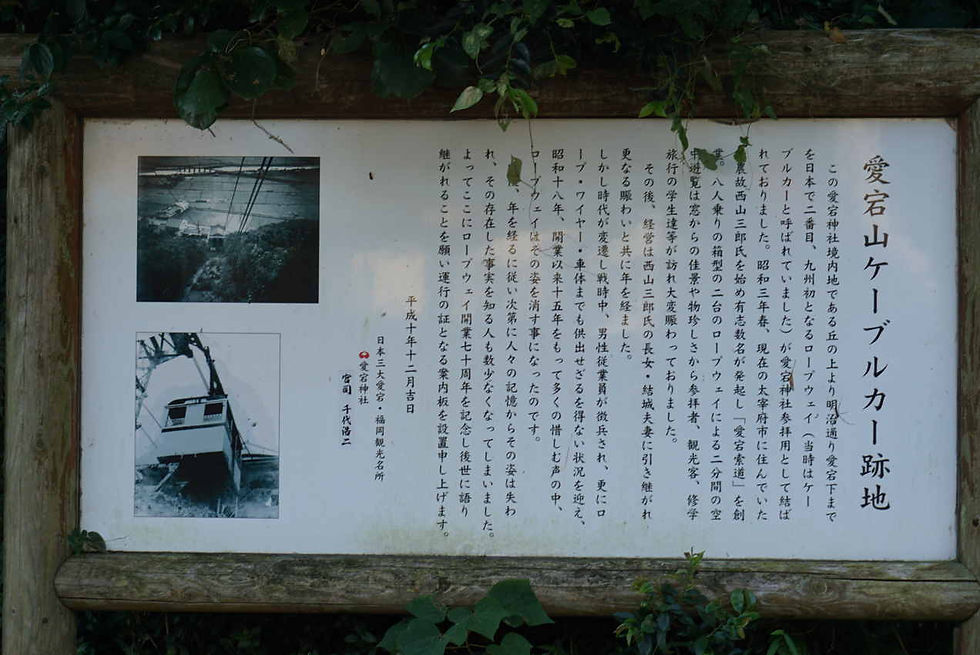
愛宕の森と緑を守る会
Atago Cableway
"Atagoyama Cable Car"
Atago Forest and Green Protection Association
For worshipers at Atago Shrine, 1928 (Showa 3), at the southern foot of Mt. A 131m long ropeway was built up to the summit of the shrine. Although it was a ropeway, it was called "Atagoyama Cable Car" for some reason (the name displayed at the platform was "Atagono Cable Car"). It was run by "Atago Cableway", which was founded by the wealthy merchant Saburo Nishiyama and others. It is the second passenger business ropeway in Japan (Note 2) and the first in Kyushu, so it was unusual and it was very busy at that time, but as the footsteps of the war became louder, male employees were increasing one after another. He was drafted and finally forced to donate iron materials (Edict No. 835, Metals Recovery Ordinance, August 1941), and disappeared in 1943 (Showa 18) as an "unnecessary non-express line". Oops. Nowadays, the brick + concrete remains of Yamagami Station are hidden in the trees, and only the remnants of them are retained. In January 2017, a survey by the Mamorukai confirmed that the remains (base) were buried in trees, mainly bamboo, and that they were even more widespread. It was found that the remains are close to 20 meters wide and have a maximum width of about 18 meters (currently under construction, but may be suspended depending on the season in consideration of ticks). I would like to continue to cherish the remains of this ropeway Yamagami station, which is also a valuable "war ruins".
Note 1: "Mt. Washio" was originally the old name of "Mt. Atago", but it is said that there was Washio Castle in this small mountain, so it is used here for convenience.
Note 2: Japan's oldest passenger business ropeway is the "Yanoko Pass Passenger Cableway" in Mie Prefecture, which opened in 1927 (Showa 2). Eight gondola with a capacity of 2 people operates 1254m.
The oldest surviving ropeway in Japan is "Yoshino Omine Cable" in Nara Prefecture, which opened in 1929 (Showa 4) and was registered as a mechanical engineering heritage in 2012.
In 2016, a film was discovered during the ropeway operation at the Fukuoka City Public Library, and was aired on May 4th in RKB Mainichi Broadcasting's Today's News. The time is short, but it has been reprocessed to make it clearer. This news video can be seen on the RKB site under the title "80-year-old video excavation" Phantom Ropeway "".
On February 17, 2017, we worked on the second excavation and maintenance work on the site of the former Yamagami station. RKB Mainichi Broadcasting covered the situation and was introduced in today's news on the 24th. If you want to see the video, click the button below (members only).


2本の支索で2台が上下していた。ゴンドラから写したと思われる。遠くに北九州鉄道の線路が見えている。

定員8人乗りの小型な箱形ゴンドラ。頂上駅。

看板には「アタゴノケーブルカー」と表示されている。これがロープウエーの正式名称か?

1928年 (昭和3年) 1月24日付福岡日日新聞(現 西日本新聞)に掲載されたロープウエー試運転の記事。麓の駅から写したもの。写真とその説明文だけで文章はない。開通後の記事は、今のところ、有無を調査中。

愛宕下から須賀神社・姪浜城があったといわれる山上までのロープウエーが表示されている。不思議なことに、ロープウエーが廃止された後の1948-1956年の地図にも載っている。

終戦直後(?)に撮られた航空写真(国土地理院)にはロープウエーの跡が明瞭に写っている。ロープウエー直下は樹が切られていたためであろう。

航空写真にロープウエーの位置を書き加えて表示した。

愛宕神社入口前(岩井屋横)にある解説板。「ケーブルカー」は実際はロープウエーだが、当時は区別なくケーブルカーと言われていた。

かつてふもとの駅があった場所。現在は明治通りに面した碇整形外科となっている。

岩井屋と「愛宕山ケーブルカー」解説板との間にある階段を上り、山上まで足をのばすと比較的平らなロープウエー山上駅の跡地に至る。

音次郎稲荷神社の駐車場の脇�に山上への登り口(階段)がある。鷲尾愛宕神社側の登り口と比べると、少々急な斜面ではある。

鷲尾城があったといわれている山の頂上に最近まで須賀神社の祠があった。この左手(東側)にロープウエー山上駅の遺構がある。

整備前の画像。ロープウエーの下側から山上駅に向かって撮影。

整備前の画像。ロープウエー山上駅の中央部にある階段の跡。この階段の両側に左右対称にコンクリートの壁がある(右の写真)。この階段の両側にゴンドラが入った。

整備前の画像。駅中央部の階段から2m程離れてコンクリート製の壁が左右にある。この写真は下から見て右側の壁。左の写真でも、植物に覆われて見えづらいが、左側の壁が写っている。

愛宕の森と緑を守る会は、樹木(主に竹)に覆われていた山頂駅跡の整備作業に取りくみ中(2017年1月〜)。

覆っていた木々を取り除くと、徐々に山上駅の姿が現れてきた。ゴンドラ発着場の奥に、石積みが見える。

左右2個所のゴンドラ発着スペースの間にあるコンクリート台の上に、このような構造物の存在も。乗降場の土台だろうか。

さらに奥の樹木を除去すれば、山上駅の全貌が現れるのではと期待される。

2018年2月撮影の山上駅跡全景。北側(駅出口・愛宕神社方向)から撮ったもの。右手にゴンドラの発着場跡、中央に動力室跡が見える。

ロープウェイを駆動する動力室の跡。床面より一段(65cm)低く、動力機械を固定していたと思われる太いボルトが床面に並んでいる。左手奥には動力源の電柱の土台も残っている。

ロープウェー山上駅直下にあった支柱台座の跡。斜面の下側から写す。中央を左上から右下に通っているワイヤーは落石防止ネットを固定するために張られているもの。

山上駅跡の直下にある支柱台座跡の脇に通っている排水路跡。

発見されたロープウェー支柱の台座跡。下側からコの字形のコンクリート構造を写す。台座は上の人影の見える所。場所は音次郎稲荷神社の斜め上側、ロープウェーの下から2/3程度に位置する。落石防止ネットで覆われている。

ロープウェー途中にある支柱台座跡から見下ろした音次郎稲荷神社。

竹を伐採後に放置すると、たちまち元の竹林へ戻ってしまいそうな勢いで新たな竹が生えて生長していく。しかし、夏にはマダニが活動的になるので、作業には注意を要する。

「愛宕ケーブルカー」解説板のある場所に、山上駅跡についての解説板と道順の案内看板を設置しました。

守る会は、山上駅跡までの山道の整備作業を進めています。 歩きにくい坂の箇所に階段を作り、歩きやすくしました。

山上駅跡への案内看板を設置しました。

山上駅跡地に説明板を設置しました。

山上駅跡の整備作業を進めていたところ、こんなものが出てきました。ブロンズ製と思われる、馬の像です。

見取図の上側がほぼ北方向。黄色い部分のみが調査前の時点で露出していた。現時点では北東部分の未整備や覆土もあって、不明な部分が残っている。